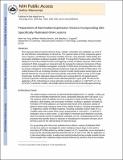Preparation of Mammalian Expression Vectors Incorporating Site-Specifically Platinated-DNA Lesions
Author(s)
Ang, Wee Han; Brown, William Wesley; Lippard, Stephen J.
DownloadLippard_Preparation of mammalian.pdf (1.173Mb)
PUBLISHER_POLICY
Publisher Policy
Article is made available in accordance with the publisher's policy and may be subject to US copyright law. Please refer to the publisher's site for terms of use.
Terms of use
Metadata
Show full item recordAbstract
FDA-approved platinum-based anticancer drugs, cisplatin, carboplatin, and oxaliplatin, are some of the most effective chemotherapies in clinical use. The cytotoxic action of these compounds against cancer requires a combination of processes including cell entry, drug activation, DNA binding, and transcription inhibition resulting in apoptotic cell death. The drugs form Pt lesions with nuclear DNA, leading to the arrest of key cellular functions and triggering a variety of cellular responses. DNA probes containing Pt−DNA conjugates are important tools for studying the molecular mechanisms of these processes. In order to facilitate investigation of specific Pt−DNA lesion processing within live cells, we devised a strategy for constructing plasmids containing a single site-specific Pt−DNA adduct. The method involves the use of nicking restriction enzymes to create closely spaced tandem gaps on the plasmid followed by removal of the intervening doubly nicked DNA strand to form a short single-stranded gap. Synthetic platinated oligonucleotides were incorporated into the gapped plasmid construct to generate a covalently closed circular platinated plasmid in good yield. We discuss the application of this methodology to prepare plasmids containing a platinum 1,2-d(G*pG*) or 1,3-d(G*pTpG*) intrastrand cross-link, two notable adducts formed by the three clinically approved drugs.
Date issued
2009-04Department
Massachusetts Institute of Technology. Department of ChemistryJournal
Bioconjugate Chemistry
Publisher
American Chemical Society (ACS)
Citation
Ang, Wee Han, William Wesley Brown, and Stephen J. Lippard. “Preparation of Mammalian Expression Vectors Incorporating Site-Specifically Platinated-DNA Lesions.” Bioconjugate Chemistry 20, no. 5 (May 20, 2009): 1058-1063.
Version: Author's final manuscript
ISSN
1043-1802
1520-4812